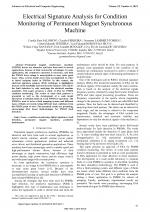| 4/2018 - 11 |
| Extra paper information in |
| Click to see author's profile in |
| Download PDF |
Author keywords
condition monitoring, digital signatures, fault detection, permanent magnet machines, predictive maintenance
References keywords
synchronous(9), stator(9), fault(9), detection(8), power(7), motors(7), permanent(6), magnet(6), electronics(6), induction(5)
Blue keywords are present in both the references section and the paper title.
About this article
Date of Publication: 2018-11-30
Volume 18, Issue 4, Year 2018, On page(s): 91 - 98
ISSN: 1582-7445, e-ISSN: 1844-7600
Digital Object Identifier: 10.4316/AECE.2018.04011
Web of Science Accession Number: 000451843400011
SCOPUS ID: 85058807078
Abstract
Permanent magnet synchronous machines (PMSMs) drives are attractive and have been used in several applications, because of their noteworthy advantages. In some applications, the continuous operation is necessary, and then the PMSM drive outage is unacceptable or may cause great losses. Thus, several studies have been accomplished in order to detect incipient faults in PMSMs. In this context, the electrical signature analysis (ESA) technique is highlighted, because of the feasibility and non-invasive features. ESA allows the fault detection by only analyzing the electrical machine quantities. This paper proposes a study of ESA for PMSM condition monitoring. The review of some fault patterns is presented as well as the development of a scale model laboratory to simulate faults in a real PMSM in operation. The PMSM is used to drive a fluid pumping system, and different types of fluids are tested, being different load conditions from the PMSM point of view. The presented results are promising, encouraging ESA based methodologies for PMSM fault detection. |
| References | | | Cited By |
Web of Science® Times Cited: 4 [View]
View record in Web of Science® [View]
View Related Records® [View]
Updated 2 weeks, 6 days ago
SCOPUS® Times Cited: 6
View record in SCOPUS® [Free preview]
View citations in SCOPUS® [Free preview]
[1] Investigation on Electromagnetic Performance of Induction Motor with Rotor Bar Faults considering Motor Current Signals, PARK, Y.-S., Advances in Electrical and Computer Engineering, ISSN 1582-7445, Issue 4, Volume 20, 2020.
Digital Object Identifier: 10.4316/AECE.2020.04005 [CrossRef] [Full text]
[2] Application of grid connected multilevel inverter for renewable energy integration, Saranya, K, Devi Shree, J, International Journal of Electrical Engineering & Education, ISSN 0020-7209, Issue 2_suppl, Volume 60, 2023.
Digital Object Identifier: 10.1177/0020720920983550 [CrossRef]
[3] Visualizing Imitation of Typical Intense X-ray Radiation Processes, LIU, H., YANG, S., Advances in Electrical and Computer Engineering, ISSN 1582-7445, Issue 1, Volume 20, 2020.
Digital Object Identifier: 10.4316/AECE.2020.01003 [CrossRef] [Full text]
Disclaimer: All information displayed above was retrieved by using remote connections to respective databases. For the best user experience, we update all data by using background processes, and use caches in order to reduce the load on the servers we retrieve the information from. As we have no control on the availability of the database servers and sometimes the Internet connectivity may be affected, we do not guarantee the information is correct or complete. For the most accurate data, please always consult the database sites directly. Some external links require authentication or an institutional subscription.
Web of Science® is a registered trademark of Clarivate Analytics, Scopus® is a registered trademark of Elsevier B.V., other product names, company names, brand names, trademarks and logos are the property of their respective owners.
Faculty of Electrical Engineering and Computer Science
Stefan cel Mare University of Suceava, Romania
All rights reserved: Advances in Electrical and Computer Engineering is a registered trademark of the Stefan cel Mare University of Suceava. No part of this publication may be reproduced, stored in a retrieval system, photocopied, recorded or archived, without the written permission from the Editor. When authors submit their papers for publication, they agree that the copyright for their article be transferred to the Faculty of Electrical Engineering and Computer Science, Stefan cel Mare University of Suceava, Romania, if and only if the articles are accepted for publication. The copyright covers the exclusive rights to reproduce and distribute the article, including reprints and translations.
Permission for other use: The copyright owner's consent does not extend to copying for general distribution, for promotion, for creating new works, or for resale. Specific written permission must be obtained from the Editor for such copying. Direct linking to files hosted on this website is strictly prohibited.
Disclaimer: Whilst every effort is made by the publishers and editorial board to see that no inaccurate or misleading data, opinions or statements appear in this journal, they wish to make it clear that all information and opinions formulated in the articles, as well as linguistic accuracy, are the sole responsibility of the author.



